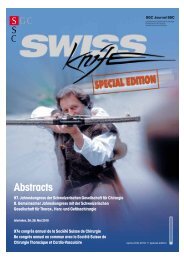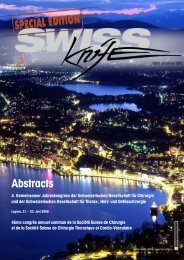Kodieren oder kapitulieren - SWISS KNIFE
Kodieren oder kapitulieren - SWISS KNIFE
Kodieren oder kapitulieren - SWISS KNIFE
Erfolgreiche ePaper selbst erstellen
Machen Sie aus Ihren PDF Publikationen ein blätterbares Flipbook mit unserer einzigartigen Google optimierten e-Paper Software.
Research<br />
British Journal of Surgery<br />
Systematic review of atraumatic<br />
splenic rupture<br />
Renzulli P, Hostettler A, Schoepfer AM,<br />
Gloor B, Candinas D<br />
Department of Visceral Surgery and Medicine, Inselspital<br />
Background: Atraumatic splenic rupture (ASR) is an ill<br />
defined clinicopathological entity.<br />
Methods: The aim was to characterize aetiological and<br />
risk factors for ASR-related mortality in order to aid disease<br />
classification and treatment. A systematic literature<br />
review (1980-2008) was undertaken and logistic regression<br />
analysis employed.<br />
Results: Some 632 publications reporting 845 patients<br />
were identified. The spleen was normal in 7.0 per cent<br />
(atraumatic-idiopathic rupture). One, two or three aetiological<br />
factors were found in 84.1, 8.2 and 0.7 per cent<br />
respectively (atraumatic-pathological rupture). Six major<br />
aetiological groups were defined: neoplastic (30.3 per<br />
cent), infectious (27.3 per cent), inflammatory, non-infectious<br />
(20.0 per cent), drug- and treatment-related (9.2 per<br />
cent) and mechanical (6.8 per cent) disorders, and normal<br />
spleen (6.4 per cent). Treatment comprised total splenectomy<br />
(84.1 per cent), organ-preserving surgery (1.2 per<br />
cent) or conservative measures (14.7 per cent). The ASRrelated<br />
mortality rate was 12.2 per cent. Splenomegaly<br />
(P = 0.040), age above 40 years (P = 0.007) and neoplastic<br />
disorders (P = 0.008) were associated with increased<br />
ASR-related mortality on multivariable analysis.<br />
Conclusions: The condition can be classified simply into<br />
atraumatic-idiopathic (7.0 per cent) and atraumatic-pathological<br />
(93.0 per cent) splenic rupture. Splenomegaly,<br />
advanced age and neoplastic disorders are associated<br />
with increased ASR-related mortality.<br />
Br J Surg. 2009; 96: 1114-1121 IF (2008) 4.921<br />
22<br />
swiss knife 2009; 4<br />
Journal of the American College<br />
of Surgeons<br />
Interpreting Study Designs in Surgical<br />
Research – A Practical Guide for<br />
Surgeons and Surgical Residents<br />
Ridgway PF, Güller U<br />
Departments of Surgery, University of Bern and University<br />
of Toronto<br />
Background: There is a variety of study designs in surgical<br />
research. In the current flourishing culture of evidenced<br />
based surgery, it is cardinal for the practicing surgeon<br />
and surgical resident to have a basic understanding<br />
of the advantages and drawbacks of each study design.<br />
Surgeons and surgical residents are often poorly trained<br />
in this area. The objective of the present manuscript is<br />
to provide a comprehensive overview of the advantages<br />
and limitations of different study designs in surgical research.<br />
Methods: We undertook a comprehensive review of<br />
current methods of surgical study designs, as well as<br />
highlighting levels of evidence and relevant statistical<br />
methodology.<br />
Results: Although the randomized clinical trial still forms<br />
the sturdiest building block of surgical research, the clinician<br />
must remain vigilant to its potential limitations. It<br />
is wrong to dismiss other study designs such as casecontrol<br />
or cohort studies as they may be the best way of<br />
answering a particular research question. Combining independent<br />
investigations with statistical techniques such<br />
as meta-analysis will increase the power. However, this<br />
does not necessarily translate into higher quality research<br />
if the individual studies upon which the analysis is based<br />
are of poor quality.<br />
Conclusions: The basic knowledge provided in the<br />
present educational review increases the practicing<br />
surgeon’s and surgical resident’s ability to decipher relevant<br />
quality research and implement important study<br />
findings into clinical practice.<br />
J Am Coll Surg. 2009; 208: 635-645 IF (2008) 3.692<br />
Achives of Orthopaedic and<br />
Trauma Surgery<br />
Open reduction and fixation of medial<br />
Moore type II fractures of the tibial<br />
plateau by a direct dorsal approach<br />
Brunner A, Honigmann P, Horisberger M,<br />
Babst R<br />
Department of Trauma Surgery, Cantonal Hospital<br />
Lucerne<br />
Background: Moore type II Entire Condyle fractures of<br />
the tibia plateau represent a rare and highly unstable fracture<br />
pattern that usually results from high impact traumas.<br />
Specific recommendations regarding the surgical treatment<br />
of these fractures are sparse. We present a series<br />
of Moore type II fractures treated by open reduction and<br />
internal fixation through a direct dorsal approach.<br />
Methods: Five patients (3 females, 2 males) with Entire<br />
Condyle fractures were retrospectively analyzed after<br />
a mean follow-up period of 39 months (range 12-61<br />
months). Patient mean age at the time of operation was<br />
36 years (range 26-43 years). Follow-up included clinical<br />
and radiological examination. Furthermore, all patient<br />
finished a SF36 and Lysholm knee score questionnaire.<br />
Results: Average range of motion was 127/0/1 degrees<br />
with all patients reaching full extension at the time of last<br />
follow up. Patients reached a mean Lysholm score of<br />
81.2 points (range 61-100 points) and an average SF36<br />
of 82.36 points (range 53.75-98.88 points). One patient<br />
sustained deep wound infection after elective implant removal<br />
1 year after the initial surgery. Overall all patients<br />
were highly satisfied with the postoperative result.<br />
Conclusions: The direct dorsal approach to the tibial<br />
plateau represents an adequate method to enable direct<br />
fracture exposure, open reduction, and internal fixation<br />
in posterior shearing medial Entire Condyle fractures and<br />
is especially valuable when also the dorso-lateral plateau<br />
is depressed.<br />
Arch Orthop Trauma Surg. 2009 Feb 24 IF (2008) 0.965
















